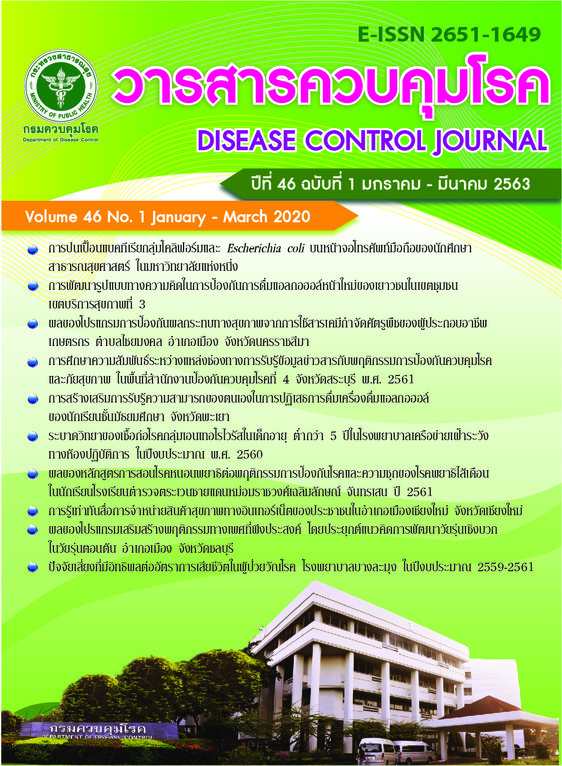Contamination of coliforms and Escherichia coli on mobile phone touchscreens of public health students at a university
DOI:
https://doi.org/10.14456/dcj.2020.1Keywords:
mobile phone, coliforms, Escherichia coliAbstract
Mobile phone is an essential part of daily life nowadays; however, it could pose a health risk from the microorganisms found on its touchscreen. This study aims to analyze the contamination of coliform bacteria and Escherichia coli on mobile phone touchscreens among public health students at a university in Nakhon Si Thammarat Province. The relationship between the behavior and hygiene in using mobile phones and the contamination of coliform bacteria was also investigated. The detection and determination of coliform bacteria was performed by using the coliform bacteria screening kit SI-2, and biochemical tests, namely Indole production test, Methyl red test, Voges-Proskauer test, and Citrate utilization test for Escherichia coli identification. The chi-square test with 95% confidence interval (CI) was used to analyze the relationship between the behavior and hygiene in using mobile phones and the contamination of coliform bacteria. The study found that 17.0% (19/112) of mobile phone touchscreens was positive for coliform bacteria and Escherichia coli was detected in 2 samples. Moreover, the behavior of using mobile phones in toilets was found to have been significantly related to the contamination of coliform bacteria (p<0.05). This study suggests that using mobile phones while in the toilets should be avoided, and good hygiene practices should be observed when using mobile phones in order to prevent the health risk arising from the exposure to microorganisms on mobile phone touchscreens.
Downloads
References
National Statistical Office Thailand. Computer, internet and mobile phones usage [Internet]. [cited 2019 May 26]. Available from: https://service.nso.go.th/nso/web/ statseries/statseries22.html (in Thai)
Information Center for Science, Technology and Innovation. Mobile telephone subscriptions per 100 inhabitants by country of ASEAN+6, 2013-2017 [Internet]. [cited 2019 May 26]. Avaliable from: https://stiic.sti.or.th/stat/ind-it/it-t005/ (in Thai)
Wattanakoon P, Piwkhom W, Chansawang P. Behavior and factors of smartphones usage among adolescents [Internet]. [cited 2019 May 26]. Available from: https://sc2.kku.ac.th/stat/statweb/images/Eventpic/60/Seminar/01_6_.pdf (in Thai)
Brady RR, Wasson A, Stirling I, McAllister C, Damani NN. Is your phone bugged? The incidence of bacteria known to cause nosocomial infection on healthcare worker’s mobile phones. J Hosp Infect 2006;62:123-5.
Brady RR, Verran J, Damani NN, Gibb AP. Review of mobile communication devices as potential reservoirs of nosocomial pathogens. J Hosp Infect 2009;71:295-300.
Pal S, Juyal D, Adekhandi S, Sharma M, Prakash R, Sharma N, et al. Mobile phones: reservoirs for the transmission of nosocomial pathogens. Adv Biomed Res 2015;4:144-9.
Famurewa O, David OM. Cell phone: a medium of transmission of bacterial pathogens. World Rural Observ 2009;1:69-72.
Yilmaz ES, Çetin SK. Investigation of Staphylococcus spp. and Escherichia coli colonization and biofilm formation on university students’ mobile phones and hands. CBU J Sci 2017; 13:839-44.
Al-Ghurabi BH, Ghaib NH, Abbas AA, Al-Musawi BK, Hassain NS, Al-Ghurabi ZH. Evaluation of microbial contamination of mobile phone among dentists in college of dentistry in Baghdad University. Int J Med Res Health Sci 2017;6:98-101.
Martínez-Gonzále NE, Solorzano-Ibarra F, Cabrera-Díaz E, Gutiérrez-González P, Martínez-Chávez L, Pérez-Montaño JA, et al. Microbial contamination on cell phones used by undergraduate students. Can J Infect Control 2017;32:211-6.
Di Lodovico S, Del Vecchio A, Cataldi V, Di Campli E, Di Bartolomeo S, Cellini L, et al. Microbial contamination of smartphone touchscreens of Italian university students. Curr Microbiol 2018;75:336-42.
Egert M, Späth K, Weik K, Kunzelmann H, Horn C, Kohl M, et al. Bacteria on smartphone touchscreens in a German university setting and evaluation of two popular cleaning methods using commercially available cleaning products. Folia Microbiol 2015;60:159–64.
Research and Laboratory Development Center, Department of Health. Guide to the food detect coliform bacteria 13. To detect contaminated food containers. For food handlers and food [Internet]. [cited 2019 May 20]. Available from: https://rldc.anamai. moph.go.th/index.php?option=com_content&view=article&id=73&Itemid=353 (in Thai)
Barrow IG, Feltham AKR. Cowan and Steel’s Manual for the Identification of Medical bacteria. 3rd ed. UK: Cambridge University; 1993.
Forbes BA, Sahm DF, Weissfeld AS. Bailey and Scott’s diagnostic microbiology. 11th ed. St Louis: Mosby; 2002.
World Health Organization. Indicators of microbial water quality [Internet]. [cited 2019 May 27]. Available from: https://www.who.int/water_sanitation_health/dwq/iwachap13.pdf
Abubakar I, Bello AY, Mohammed D, Nata’ala K, Aliyu M. Occurrence of bacterial species from mobile phones of students from two departments in Niger State Polytechnic Zungeru, Nigeria. LAJANS 2017;2:72-7.
Chitpirom K. Evaluation and bacterial contamination of public toilets. KKU Sci J 2013;41:789-96. (in Thai)
Chitpirom K, Polyong C, Chitpirom P. Contamination of antibiotic resistant bacteria from toilets, Thon Buri District, Bangkok. Dis Control J 2018;44:38-49. (in Thai)
Ogba O, Obio O. Microbial spectrum on public toilet seats. Ann Microbiol Infect Dis 2018;1:58-62.
Kramer A, Schwebke I, Kampf G. How long do nosocomial pathogens persist on inanimate surfaces? A systematic review. BMC Infect Dis 2006;6:130.
Koscova J, Hurnikova Z, Pistl J. Degree of bacterial contamination of mobile phone and computer keyboard surfaces and efficacy of disinfection with Chlorhexidine Digluconate and Triclosan to its reduction. Int J Environ Res Public Health 2018;15:2238.
Downloads
Published
How to Cite
Issue
Section
License
Articles published in the Disease Control Journal are considered as academic work, research or analysis of the personal opinion of the authors, not the opinion of the Thailand Department of Disease Control or editorial team. The authors must be responsible for their articles.






